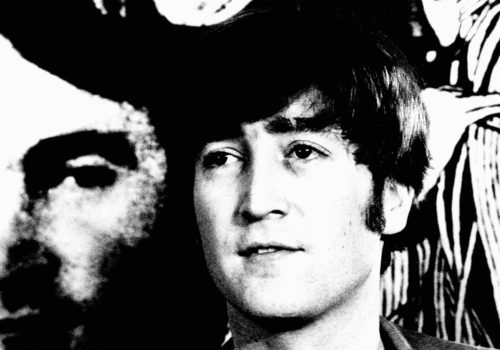In August of 1966, amidst much ado, The Beatles arrived at the Capitol Records Tower in Los Angeles to promote the release of their new recording, Revolver. Besides the now familiar frenzy of “Beatlemania” the group was dogged in the US at the time by the controversy surrounding John Lennon’s statements from five months prior saying that the group was “More popular than Jesus”—a quotation that the press immediately pounced on that day.
What was less obvious amidst all storm and stress of the event, was that The Beatles had just released an album that elevated pop music to a full-fledged art form—an album length statement that would serve as the template, not only for their future accomplishments as a group and solo songwriters, but for the whole future trajectory of popular music.
In attendance that day was the 27 year old photographer Ralph Gibson. Gibson had approached the art department at Capitol Records as a freelance photographer and was invited to photograph the press conference with the directive that he was to document the events in a creative way that would be distinct from typical press photography.
Gibson jumped into the project enthusiastically, photographing the group in a variety of subjective ways. Some of the pictures pull back and portray the circus-like nature of the event itself: the room crowded to capacity with members of the press—the half dozen security guards that flanked the band on each side. Other photographs pull in close and drop out the surroundings altogether, serving as sensitive portraits of the young men who found themselves within the eye of this storm. Other shots boldly crop the musicians, we see John and Ringo’s eyes as they scan the room (evoking the album art for the North American release of A Hard Day’s Night), another shot focuses on the two bandmates’s hand gestures as Ringo lights John’s smoke.
Some of the most intriguing photos immerse the band members in Klaus Voormann’s Grammy-award-winning album art which was enlarged on the wall for the occasion. In one picture, Paul McCartney seems to be a part of the black and white photo-montage that ‘s folded within the line drawn portraits on the album’s cover. The illusion is only broken when our eye falls on the framed record behind Paul’s head.
Gibson’s enthusiasm for the project was evident—he returned to his darkroom in the Beverly Glen neighborhood that evening and stayed up all night printing. By noon the next day he had 16 prints. The Capitol Records art department loved the photographs and immediate plans were made to publish a book. Gibson was keenly interested in books and book-making so this felt like the break he had been waiting for. A layout dummy book was produced with the intention of rushing it to press.
Gibson left that day, sure that his career as photographer and book-maker was about to experience a turbocharged take off. In the end, the project fell victim to the same frenzied enthusiasm that it hoped to capitalize on—later that night the book dummy was stolen from the art department and, with that, the project was canceled. The original 16 prints that Gibson made that night are all that remain.
Later that year Gibson moved from his native Los Angeles to New York City where he worked with Magnum. In 1970, despite being nine months late on his rent to the Chelsea Hotel, he paid $4,000 to publish his first photobook The Somnambulist. Gibson credits the publication of that book, as well as the others that followed, as the move that allowed him creative freedom going forward, saying they gave him the recognition he required to be able to do his work.
The Beatles, suffering an excess of recognition themselves, chose to make Revolver the last album that they toured in support of. This decision freed them to focus on recording subsequent LPs that would virtually define the landscape of popular music for generations to come: Sgt. Pepper’s Lonely Hearts Club Band, The White Album, and Abbey Road.
Laurence Miller
Laurence Miller Gallery offers this unique set of 16 vintage prints—a portrait of a band, and a photographer, at a creative crossroads
Laurence Miller Gallery : Ralph Gibson : The Beatles 1966
Online Exhibition
December 9, 2021 – February 12, 2022
http://www.laurencemillergallery.com/exhibitions/ralph-gibson
Laurence Miller Gallery
9 East 8th St, Box 119, New York, NY 10003
















